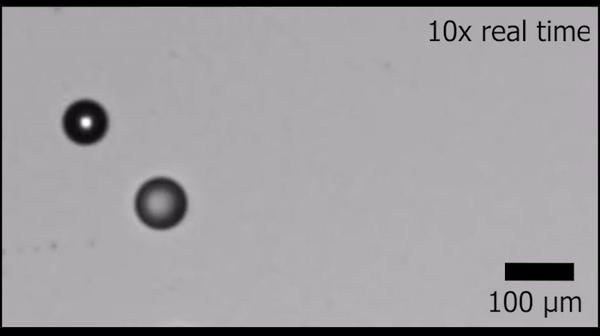Researchers design system that emulates life-like behavior in non-living system

Credit: Zarzar Laboratory/Nature Chemistry
Oil droplets can be made to act like predators, chasing down other droplets that flee like prey. The behavior, which is controlled by chemical signaling produced by the droplets, mimics behavior seen among living organisms but, until now, had not been recreated in synthetic systems. This tunable chemical system could potentially serve a model to help understand interactions in many-body systems such as schools of fish, bacterial colonies, or swarms of insects.
An international team of researchers led by Penn State scientists describe the system in a paper published November 16, 2020 in the journal Nature Chemistry.
“By controlling the chemistry of the oil droplets, we can create a system in which the droplets behave actively and communicate with each other through chemical gradients,” said Lauren Zarzar, assistant professor of chemistry at Penn State and the leader of the research team. “The exciting thing that we found is that you can design a system of droplets that exhibit ‘non-reciprocal’ interactions. One droplet is attracted to the other, while the other is repelled, similar to the behavior of predator and prey.”
The researchers place microscale droplets of the two different oils into a solution of water and a surfactant–a compound commonly found in soaps that lowers the surface tension of liquids. One of the oils dissolves more easily in the surfactant solution causing those droplets to emit a chemical gradient of oil molecules into its surroundings. Droplets are repelled by the dissolved oil.
“Initially this cloud of oil around the droplets is basically symmetrical and the droplets don’t move,” said Caleb Meredith, a graduate student at Penn State and co-first author of the paper. “But what we discovered is that the prey droplets can actually uptake some of the oil released by the predator droplets, setting up a source-sink exchange of oil between the droplets. When the droplets get close enough, it creates an asymmetry in the chemical gradient between the two droplets and causes the predator droplet to move towards the prey, setting up a chase.”
The asymmetry of the oil chemical gradient generated by the source and sink causes a difference in the surface tension across the surface of both the predator and prey droplets. The gradient causes the predator droplet (source) to move toward the prey droplet (sink). Similarly, due to the effect of the predator’s emitted chemical gradient, the prey is repelled by the approaching predator.
“One of the surprising results is that the two oil droplets don’t need to be very different chemically from each other to elicit this behavior,” said Zarzar. “We looked at a wide variety of chemical compositions for the oils and surfactant, which allowed us to establish a set of rules that govern these interactions. We can use these rules to tune the strength of the interactions by controlling the compositions of the droplet oils or surfactant.”
The research team also developed a model, which based on measurements of the speeds of chasing between individual pairs of droplets, was able to accurately simulate the motion of many droplets and show how they organize into larger clusters that move in a variety of fashions.
“They really look to me like they’re alive sometimes,” said Meredith. “When multiple droplets get together into clusters they can start to rotate, stop-and-go, move in spirals, and even split apart into smaller clusters.”
The researchers say that by understanding the types of rules that govern these interactions, their system could eventually be used for experimentally modeling many-body systems ranging from the behavior of large numbers of animals to the interactions that might have played a role in the evolution of early life.
“What we are doing is really basic, fundamental research where the motivation is to understand the processes at work that can control the activity of inanimate things like the oil droplets,” said Zarzar. “But, these ideas could find application in other areas, like self-assembly, group behaviors, and even in thinking about the origins of life on Earth where mixtures of simple chemical components had to somehow organize into non-equilibrium structures. Clearly, we are not looking at the same chemicals, but we may be able to establish parameters or conditions that, for example, give rise to similar types of interactions that occurred.”
###
In addition to Zarzar and Meredith, the research team includes Yu-Jen Chiu at Penn State and Pepijn G. Moerman, Jan Groenewold, Willem K. Kegel, and Alfons van Blaaderen at Utrecht University in the Netherlands.
The research was supported by the Army Research Office, the U.S. National Science Foundation funded Penn State Materials Research Science and Engineering Center (MRSEC), the Thomas and June Beaver Fellowship at Penn State, the Pennsylvania Space Grant Fellowship, the Erickson Discovery Grant program at Penn State, the NWO (Dutch national science foundation) Graduate Program through the Debye Institute for Nanomaterials, and the Guangdong Innovative Research Team Program.
Media Contact
Sam Sholtis
[email protected]
Original Source
https:/
Related Journal Article
http://dx.




